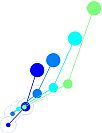Norepinephrine (NE) is released throughout most of the central nervous system from the locus coeruleus (LC). LC-NE neurons modulate arousal, attention, and learning. This panoply of functions is often ascribed to broad projections across the brain.
We asked whether LC-NE neurons comprise distinct types of neurons with different functions during learning in mice. Electrophysiological recordings in brain slices revealed two LC-NE cell types with distinct shapes of action potentials: wide (type I) and narrow (type II) populations. We made in vivo extracellular electrophysiological recordings and similarly found two clusters of action potential shapes among identified LC-NE neurons.
To test whether these distinct types of LC-NE neurons had different functions, we measured action potentials from LC-NE neurons in a behavioral task requiring learning from reward prediction errors (RPE) . Mice were trained to make choices upon go-cue to lick leftward or rightward for reward with changing probabilities. Because there were no explicit cues about reward probability change, mice had to base their decisions on reward and choice history alone.
Types I and II LC-NE neurons responded differently to decision outcomes. Type I neurons were excited by RPE while type II neurons were excited by lack of reward. Activity of the two types of neurons correlated with changes in future choices in opposite ways: higher activity in type I neurons predicted positive changes in policy updates (consistent with RPE), whereas higher activity in type II neurons predicted negative changes in policy updates.
To determine if the two types of LC-NE neurons are sending the two learning signals to different brain regions, we performed two experiments. First, we used antidromic stimulation with collision tests to record spikes from LC-NE neurons with projections to frontal cortex. Second, we optically measured axonal calcium dynamics in LC-NE axons in frontal cortex, cerebellum, and medulla. LC-NE input to frontal cortex showed dynamics resembling that of Type I neurons, which positively correlated with RPE. These results reveal a link between the structure and function of a major neuromodulatory system in the brain and show that NE provides a signal for cortex to learn from reinforcement .

 PDF version
PDF version
